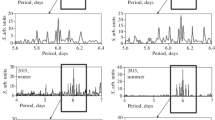Abstract
Results of studying the lunar daily geomagnetic variations in the spectral and time regions at the network of observatories are presented. The seasonal variations in the amplitudes of the fundamental harmonic constituents of three lunar variation components have been revealed. The seasonal time variations have been analyzed using the digital bandpass filtering and harmonic synthesis based on the data of the Kakioka and Memambetsu geomagnetic observatories. The 11-year solar cycle and annual and semiannual periods have been distinguished in the seasonal variation spectrum. Studying the spectral singularities of the lunar daily variation at these observatories and the sea level variations in daytime and nighttime hours has made it possible to identify the contribution of the oceanic dynamo to the lunar variation vertical component.
Similar content being viewed by others
References
S.-I. Akasofu and S. Chapman, Solar-Terrestrial Physics (Pergamon, Oxford, 1972; Mir, Moscow, 1975).
S. I. Baskakov, Radiotechnical Circuits and Signals (Vysshaya Shkola, Moscow, 1988) [in Russian].
J. Bendat and G. Piersol, Random Data: Analysis and Measurement Procedures (New York etc., 1986; Mir, Moscow 1989).
M. Cueto, D. McKnight, and M. Herraiz, “Daily Geomagnetic Variations on the Iberian Peninsula,” Geophys. J. Int. 152, 113–123 (2003).
S. A. Cummer, “Modeling Electromagnetic Propagation in the Earth-Ionosphere Waveguide,” IEEE. Trans. Antennas Propag. 48(9), 1420–1429 (2000).
J. L. Davis, P. Elosegui, J. X. Mitrovica, and M. E. Tamisiea, “Climate-Driven Deformation of the Solid Earth from GRACE and GPS,” Geophys. Res. Lett. 31, L24605 (2004).
F. De Meyer, “A Modulation Model for the Solar and Lunar Daily Geomagnetic Variations,” Earth Planet. Space 55, 405–418 (2003).
I. S. Gonorovskii, Radiotechnical Circuits and Signals (Sov. Radio, Moscow, 1977) [in Russian].
R. Leitinger, N. Jakowski, G. K. Hartmann, and E. Feichter, http:www.mps.mpg.de/dokumente/projekte/mas/dust-2/tec.pdf.2000.
S. R. C. Malin, “Separation of Lunar Daily Geomagnetic Variation into Parts of Ionospheric and Oceanic Origin,” Geophys. J. R. Astron. Soc. 21, 447–455 (1970).
S. R. C. Malin, M. K. Tuncer, and O. Yazici-Cakin, “Systematic Analysis of Geomagnetic Observatory Data-I. A Proposed Method,” Geophys. J. Int. 126, 635–644 (1996).
S. L. Marple, Jr., Digital Spectral Analysis (Englewood Cliffs, New York, 1987; Mir, Moscow, 1990).
S. Maus, R. Tyler, and H. Luhr, http://gfz-pots-dam.de/pb2/pb23/SatMag/Doc/Poster1_A4.pdf, 2003
J. D. McKnight, “Lunar Daily Geomagnetic Variations in New Zealand,” Geophys. J. Int. 122, 889–898 (1995).
P. Melchior, The Earth Tides (Pergamon press, Oxford, 1966; Mir, Moscow, 1968).
N. Olsen, F. Lowes, and T. J. Sabaka, “Ionospheric and Induced Field Leakage in Geomagnetic Field Models, and Derivation of Candidate Models for DGRF 1995 and DGRF 2000,” Earth Planet. Space 57, 1191–1196 (2005).
W. D. Parkinson, Introduction to Geomagnetism (Scottish Acad. Press, Edinburg, 1983; Mir, Moscow, 1986).
L. R. Rabiner and B. Gold, Theory and Application of Digital Signal Processing (Prentice-Hall, Englewood Cliffs, N.J., 1975; Mir, Moscow, 1978).
W. G. V. Rosser and D. M. Schlapp, “Geomagnetic Lunar Variations Due to the Ocean Dynamo Measured at European Observatories,” Geophys. J. Int. 103, 257–260 (1990).
M. Shiraki, “Effect of Oceanic Dynamo on the Lunar Daily Geomagnetic Variation at Kakioka, Memambetsu and Kanoya, Japan, 1958–1973,” Mem. Kakioka Magn. Obs. 17(2), 49–58 (1978b).
M. Shiraki, “S q and L q Variations at Kakioka, Memambetsu and Kanoya, Japan, 1958–1973,” Mem. Kakioka Magn. Obs. 17(2), 71–76, (1978a).
S. S. Starjinsky, “On a Fine Structure of the Lunar Daily Geomagnetic Variation,” Dokl. Ross. Akad. Nauk 398(1), 109–112 (2004).
R. J. Stening and D. E. Winch, “The Lunar Geomagnetic Tide at Night,” Geophys. J. R. Astron. Soc. 88, 461–476 (1987).
R. H. Tyler, S. Maus, and H. Luhr, “Satellite Observations of Magnetic Fields Due to Ocean Tidal Flow,” Science 299, 239–244 (2003).
J. Wahr, S. Swenson, V. Zlotnicki, and I. Valicogna, “Time-Variable Gravity from GRACE: First Results,” Geophys. Res. Lett. 31(11), L11501 (2004).
B. M. Yanovskii, Terrestrial Magnetism (Leningr. Gos. Univ., Leningrad, 1964).
Author information
Authors and Affiliations
Additional information
Original Russian Text © S.S. Starjinsky, 2008, published in Geomagnetizm i Aeronomiya, 2008, Vol. 48, No. 2, pp. 275–286.
Rights and permissions
About this article
Cite this article
Starjinsky, S.S. Studying the dynamics of the lunar daily geomagnetic variations. Geomagn. Aeron. 48, 265–276 (2008). https://doi.org/10.1134/S0016793208020175
Received:
Accepted:
Published:
Issue Date:
DOI: https://doi.org/10.1134/S0016793208020175



